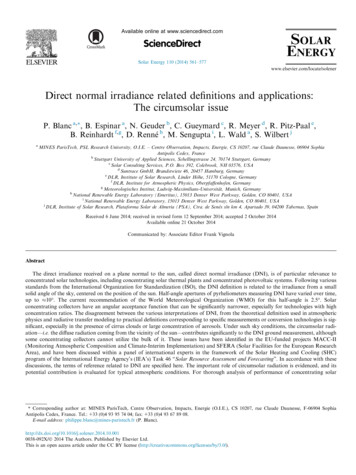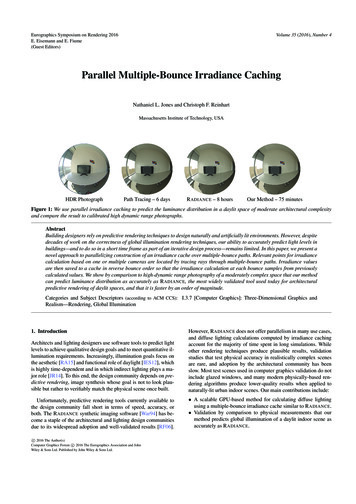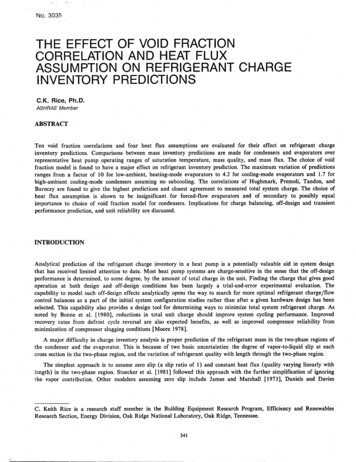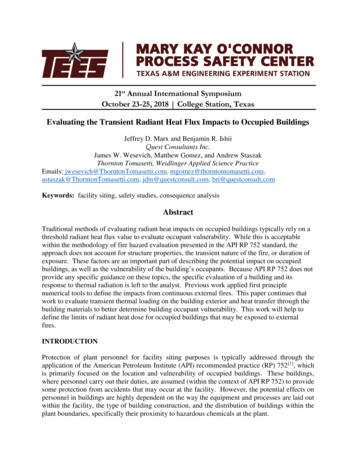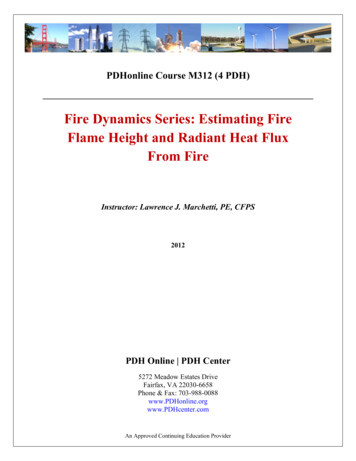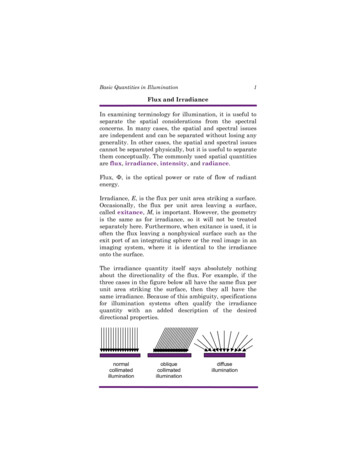
Transcription
Basic Quantities in Illumination1Flux and IrradianceIn examining terminology for illumination, it is useful toseparate the spatial considerations from the spectralconcerns. In many cases, the spatial and spectral issuesare independent and can be separated without losing anygenerality. In other cases, the spatial and spectral issuescannot be separated physically, but it is useful to separatethem conceptually. The commonly used spatial quantitiesare flux, irradiance, intensity, and radiance.Flux, Φ, is the optical power or rate of flow of radiantenergy.Irradiance, E, is the flux per unit area striking a surface.Occasionally, the flux per unit area leaving a surface,called exitance, M, is important. However, the geometryis the same as for irradiance, so it will not be treatedseparately here. Furthermore, when exitance is used, it isoften the flux leaving a nonphysical surface such as theexit port of an integrating sphere or the real image in animaging system, where it is identical to the irradianceonto the surface.The irradiance quantity itself says absolutely nothingabout the directionality of the flux. For example, if thethree cases in the figure below all have the same flux perunit area striking the surface, then they all have thesame irradiance. Because of this ambiguity, specificationsfor illumination systems often qualify the irradiancequantity with an added description of the desireddirectional imatedilluminationdiffuseillumination
Illumination2Solid AngleThe definition of intensity involves the concept of a solidangle. A solid angle is a 3D angular volume that isdefined analogously to the definition of a plane angle intwo dimensions.A plane angle, θ, made up of the lines from two pointsmeeting at a vertex, is defined by the arc length of a circlesubtended by the lines and by the radius of that circle, asshown below. The dimensionless unit of plane angle is theradian, with 2π radians in a full circle.AABθlθθ l/r(radians)rOBO2π radians ina full circleA solid angle, ω, made up of all the lines from a closedcurve meeting at a vertex, is defined by the surface areaof a sphere subtended by the lines and by the radius ofthat sphere, as shown below. The dimensionless unit ofsolid angle is the steradian, with 4π steradians in a fullsphere.Closed curverωarea, a,onsurface ofsphereωω a/r2 (steradians)4π steradians ina full sphere
Basic Quantities in Illumination3Intensity, Radiance, and Projected Solid AngleIntensity, I, is the flux per unit solid angle. It is theamount of flux from a point source contained in a smallangular volume. A source can be considered a point sourcefor this application if the irradiance falls off as theinverse square of the distance from the source.Intensity, for a given source, can vary with direction.The term “intensity” is used in many disciplines, someeven closely related to optics, to mean things otherthan flux per unit solid angle. Use caution and rely oncontext to determine the meaning of the word in aparticular situation.Radiance, L, applies to extended sources and surfaces. Itis the flux per unit solid angle per unit projected area ofthe source or surface. The projected area is the projectionof the area onto a surface normal to the direction of viewand is equal to the actual area times the cosine of theangle between the surface normal and the direction ofview. Radiance can vary with position on a surface, andlike intensity, it can vary with direction. A source orsurface with constant radiance in all directions is calledLambertian. A Lambertian source or surface hasintensity that varies with the cosine of the angle with thesurface normal.In many cases, the angle of view changes over the extentof the receiver. These cases require an alternate definitionof radiance: radiance is the flux per unit area per unitprojected solid angle. (In fact, this is the more generaldefinition and covers the simpler case where the entiresurface of the extended source is at essentially the sameangle as the direction of view.)
Illumination4Solid Angle and Projected Solid AngleThe relationship between solid angle and projected solidangle can be confusing. Projected solid angle has meaningprimarily for a small Lambertian source, which hasintensity that varies as the cosine of the angle with thesurface normal. The projected solid angle, Ω, is thesolid angle, ω, weighted by the cosine of the angle withthe surface normal.ωΩ ω cos ϕϕWhen the solid angle is large enough so that the anglewith the surface normal is not the same over the entiresolid angle, the total projected solid angle must becomputed by integrating the incremental projected solidangles. See the reference by Bartell for a more detailedexplanation.For some special cases, the integration results in simpleexpressions, such as for a large circular cone that isnormal to a surface and subtends a half angle, θ.θΩ π sin2 θA hemisphere has 2π steradians (solid angle) but πprojected steradians (projected solid angle).
Basic Quantities in Illumination5Spectroradiometric and Radiometric QuantitiesIn the spectral dimension of illumination, the mostgeneral view looks at the spectral density—the amount ofradiation per unit wavelength interval. In terms of thefour spatial quantities already considered, the spectralquantities are spectral flux, Φλ; spectral irradiance,Eλ; spectral intensity, Iλ; and spectral radiance, Lλ.These quantities, usually written with a subscript toindicate that they are integrable, must be integrated todetermine the amount of radiation in a particular spectralband. For example, the total radiant flux, Φ (in units ofwatts), in the band between wavelength λ1 andwavelength λ2 isλ2Φ ( λ1, λ2) Φλ( λ ) dλ.λ1Similar expressions can be written for the totalirradiance, E (watts/m2); total radiant intensity, I(watts/ sr); and total radiance, L (watts/m2·sr).Photometry measures the response of the human eye tolight. Although not everyone has exactly the sameresponse, the standardized CIE 1924 luminousefficiency function works very well for most people.(The CIE is the International Commission onIllumination.) This function, shown on the following page,is designated V(λ). The values for this function, in 5-nmincrements, are given in the Appendix. Not coincidentally,this function is identical to the CIE color matchingfunction, ȳ. The unit of luminous (photopic) flux is thelumen. The luminous flux is found from the spectral fluxand the V(λ) function from the following relationship:luminous flux 683 Φ λ ( λ ) V ( λ ) dλ.The factor of 683 in this equation comes directly from thedefinition of the fundamental unit of luminous intensity,the candela.
6IlluminationPhotometric QuantitiesCIE 1924 Luminous Efficiency(Vλ)Luminous Efficiency1.00.80.60.40.20.0350 400 450 500 550 600 650 700 750 800wavelength (nm)Notes on notation: The photopic quantities of flux, irradiance,intensity, and radiance are called luminous flux,illuminance,luminousintensity,andluminance, respectively. These quantities are sometimes notated with asubscript “v” (for visual), as Φv, Ev, Iv, and Lv. Butoften the subscript is omitted since the meaning isusually clear from the context, and it could beconfused with the subscript notation oftenreserved for integrable quantities. The designations Φ, E, I, and L are common butnot universally standard. Another set of symbolssometimes used is P, H, J, and N, respectively, forradiometric quantities; Pλ, H λ, J λ, and N λ forspectral quantities; and F, E, I, and B for thecorresponding photometric quantities. Solid angle and projected solid angle are notalways distinguished by ω and Ω, respectively.
Basic Quantities in Illumination7Matrix of Basic lWatts sr·nmSpectralradiancePhotopicLuminous fluxLumens rcandela ·srThe table above shows the four spatial quantities and thethree spectral categories that are discussed in thepreceding pages. These create 12 distinct cells that coverthe vast majority of specifications for illuminationsystems.Flux/area·solidangleWith two exceptions, both used mainly in the UnitedStates, work in illumination is almost always done in SIunits. The two exceptions (both deprecated) are:Illuminance1 footcandle (lm/ft2) 10.764 lux (lm/m2)Luminance1 footlambert (candela/πft2) 3.426 nit (candela/m2)
8IlluminationPhotopic and Scotopic VisionThe human visual system responds to light over a widedynamic range, in excess of 6 orders of magnitude. Toachieve this dynamic range, the mechanisms for highlight-level vision and low-light-level vision are different.The high-level region, called the photopic region, isactive at luminance levels above about 3 cd/m2. The lowlevel region, called the scotopic region, is active belowapproximately 0.01 cd/m2. The region between purephotopic and pure scotopic is called the mesopic region,where the visual response is a mixture of the two. Thephotopic efficiency, usually designated V(λ), peaks at555 nm, while the scotopic efficiency, usuallydesignated V′(λ), peaks at 507 nm.Luminous EfficiencyScotopic and PhotopicLuminous 00750800wavelength (nm)The values for photopic efficiency and scotopic efficiency,both in 5-nm increments, are given in the Appendix.
Basic Quantities in Illumination9Luminous EfficacyLuminous efficacy, quantified in lumens per watt, is ameasure of the ability of a light source to produce a visualresponse from its power. In the photopic region, luminousefficacy peaks at 683 lumens per watt at 555 nm. In fact,the lumen is defined in terms of the power at 555 nm(frequency of 540 1012 Hz). Specifically, the definition(adopted in 1979) is in terms of the candela (lumen persteradian).The candela is the luminous intensity, in a givendirection, of a source that emits monochromaticradiation at a frequency of 540 1012 Hz and that hasa radiant intensity in that direction of 1/683 Watt persteradian.Luminous Efficacy (lm/W)Luminous Efficacy(photopic)7006005004003002001000350 400 450 500 550 600 650 700 750 800wavelength (nm)It is usually clear from the context whether the power isthe radiated power (as in the discussion above) or, oftenfor lamps, the “wall-plug” power.
10IlluminationTypical Values of Illumination QuantitiesIrradiance and IlluminanceDirect sunlight1000W/m22500nm)Direct sunlight100,000 luxShade10,000 luxOvercast day1,000 luxOffice space300–600 luxFull moon0.2 luxQuarter moon0.01 luxMoonless clear night0.001 luxLuminous IntensityAutomobile headlight5,000–20,000 cdHousehold flashlight100–1,000 cd100-W tungsten lightbulb100 cdLED traffic signal250–700 cdSingle LED1 mcd–25 cdRadiance and LuminanceSun2 x 107 W/m2·sr(250-2500nm)Sun2 x 109 nitFrosted lightbulb100,000 nitFluorescent lamp5,000 nitComputer screen100 nit(250-Wavelength Ranges for IlluminationUV-C*250 to 280 nmUV-B280 to 315 nmUV-A315 to 400 nmVisible 360–400 to 760–800 nmNear-infrared (NIR)†760 nm to 1.1 µm* Actual definition of UV-C is 100 to 280 nm. However, therange from 100 to 250 nm is not of interest forillumination systems.† Actual definition of NIR is to 1.4 µm. However, 1.1 µm isthe upper limit for silicon-based detectors.
Flux, Φ, is the optical power or rate of flow of radiant energy. Irradiance, E, is the flux per unit area striking a surface. Occasionally, the flux per unit area leaving a surface, called exitance, M, is important. However, the geometry is the same as for irradi
